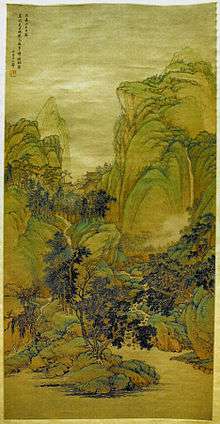Wang Hui (Qing dynasty)
| Wang Hui | |
|---|---|
 | |
| Born |
1632 Changshu, Jiangsu |
| Died | 1717 (aged 84–85) |
| Known for | Shan shui |
Wang Hui (simplified Chinese: 王翚; traditional Chinese: 王翬; pinyin: Wáng Huī; 1632–1717) was a Chinese landscape painter, one of the Four Wangs. He, and the three other Wangs, dominated orthodox art in China throughout the late Ming and early Qing periods. Of the Four Wangs, Wang Hui is considered the best-known today.
Beijing, Shanghai and Taipei museums loaned works for "Landscapes Clear and Radiant: The Art of Wang Hui (1632-1717)" in 2008 at the Metropolitan Museum of Art in New York.[1]
Biography
Wang Hui followed in the footprints of his great grandfathers, grandfather, father and uncles and learned painting at a very early age. He was later taught by two contemporary masters, Zhang Ke and Wang Shimin, who taught him to work in the tradition of copying famous Chinese paintings. This is most likely the reason why critics claim that his work is conservative and reflects the Yuan and Song traditions. One critic claimed that "his landscape paintings reflect his nostalgic attachment to classical Chinese aesthetics." Along with the other Wangs, Wang Hui helped to perpetuate the tradition of copying the ancient masters rather than creating original work.
Gallery
 Wang Hui, A Thousand Peaks and Myriad Ravines 1693
Wang Hui, A Thousand Peaks and Myriad Ravines 1693 Wang Hui, (need title)
Wang Hui, (need title) Wang Hui, Thousand miles along the Jangtse 1700
Wang Hui, Thousand miles along the Jangtse 1700 Wang Hui, Mountains, Streams, and Autumn Trees
Wang Hui, Mountains, Streams, and Autumn Trees Wang Hui, Hut in the autumn rain
Wang Hui, Hut in the autumn rain Wang Hui, Fisherman Huts and Clearing Skies in Autumn
Wang Hui, Fisherman Huts and Clearing Skies in Autumn The Beauty of Green Mountains and Rivers 1679
The Beauty of Green Mountains and Rivers 1679 Tree in Autumn and Crows, dated 1712
Tree in Autumn and Crows, dated 1712
References
- ↑ Smith, Roberta (September 11, 2008). "Master of Many Styles, and Many Mentors". The New York Times. Retrieved 2008-09-12.
Further reading
- Fong, Wen C.; et al. (2008). Landscapes clear and radiant: the art of Wang Hui (1632-1717). New York: The Metropolitan Museum of Art. ISBN 9781588392916.
| Wikimedia Commons has media related to Wang Hui. |
External links
- Wang Hui in the collection of the National Palace Museum, Taipei
- Wang Hui in the collection of the Metropolitan Museum, New York